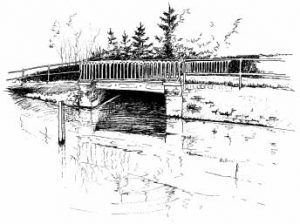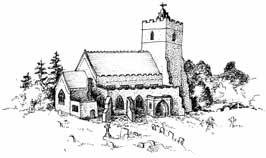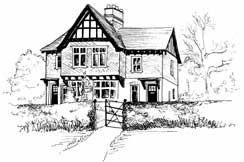The big house on the corner opposite the Village Shop was until 1986 a pub called the Rose & Crown (which once had a slaughter-house behind it). The next house on the left is the elegant Wheatsheaf House (the old Manse, and also once a private school), while the cottage opposite, which is set back from the road and at an angle to it, was once a nuns’ retreat. The bridge was erected in 1851 and cast in Leiston by the famous steam engine manufacturer Richard Garrett (though the plaque describing this is on the side of the bridge and only visible to amphibious walkers). This is a good spot to look out for kingfishers, which nest nearby. By the bridge is a ford and a measuring stick indicates the depth of water in the channel. Just the other side on the left is Bridge Cottage and opposite that is the walled garden of Great Thurlow Hall, a handsome Georgian building and home to such important local families as the Vernons, the Smiths (descended from the founder of WHS), the Ryders (Sue Ryder spent her childhood here) and now a branch of the Vesteys (George and Rachel and family). The splendid gardens are regularly opened to the public to see the spectacular seasonal displays of snowdrops and daffodils.

All Saints Church has Norman origins and a font that may be Norman, but the church was extensively restored in 1741, 1880 and 1956. There are some famous graffiti on a pillar in the church, possibly dating back to the 14th century and now rather obscured but including some very appealing depictions of archers practising with long bows. A more modern artwork is the statuette by Elizabeth Frink, commissioned in memory of Ronald Vestey. In the extension churchyard across the road there is a bench presented in 1974 by Mrs and Miss Haylock of the then Rose & Crown and their customers. The weather-boarded house on the left was the former modern vicarage, and on the right opposite the row of white cottages is the restored village barn of 1614, now a venue for grand parties and festivities.


Church and Hall Farms face each other and there is a public footpath off to the right which leads through the farmyard, across fields and along the river eventually to Great Wratting. The green shed on the right was once the Ryders’ estate office and beyond it is an old dovecote.
There is then a fine row of trees on the right, mostly chestnuts and limes, behind which there is a long pond (full of frog-spawn in spring). Going up the hill you see a striking Victorian cottage on the left (once known as Pepper Hall) which has decorative hanging tiles and a plaque with the Latin motto, Deo non fortuna fretus (‘reliant on God not on fortune’). Near the top of the hill are some further cottages, inscribed RAV 1954 and 1949, indicating that they were built by Ronald Vestey (father of Edmund). Beyond this, the road runs between arable fields up to the ancient Trundley Wood on the right.

